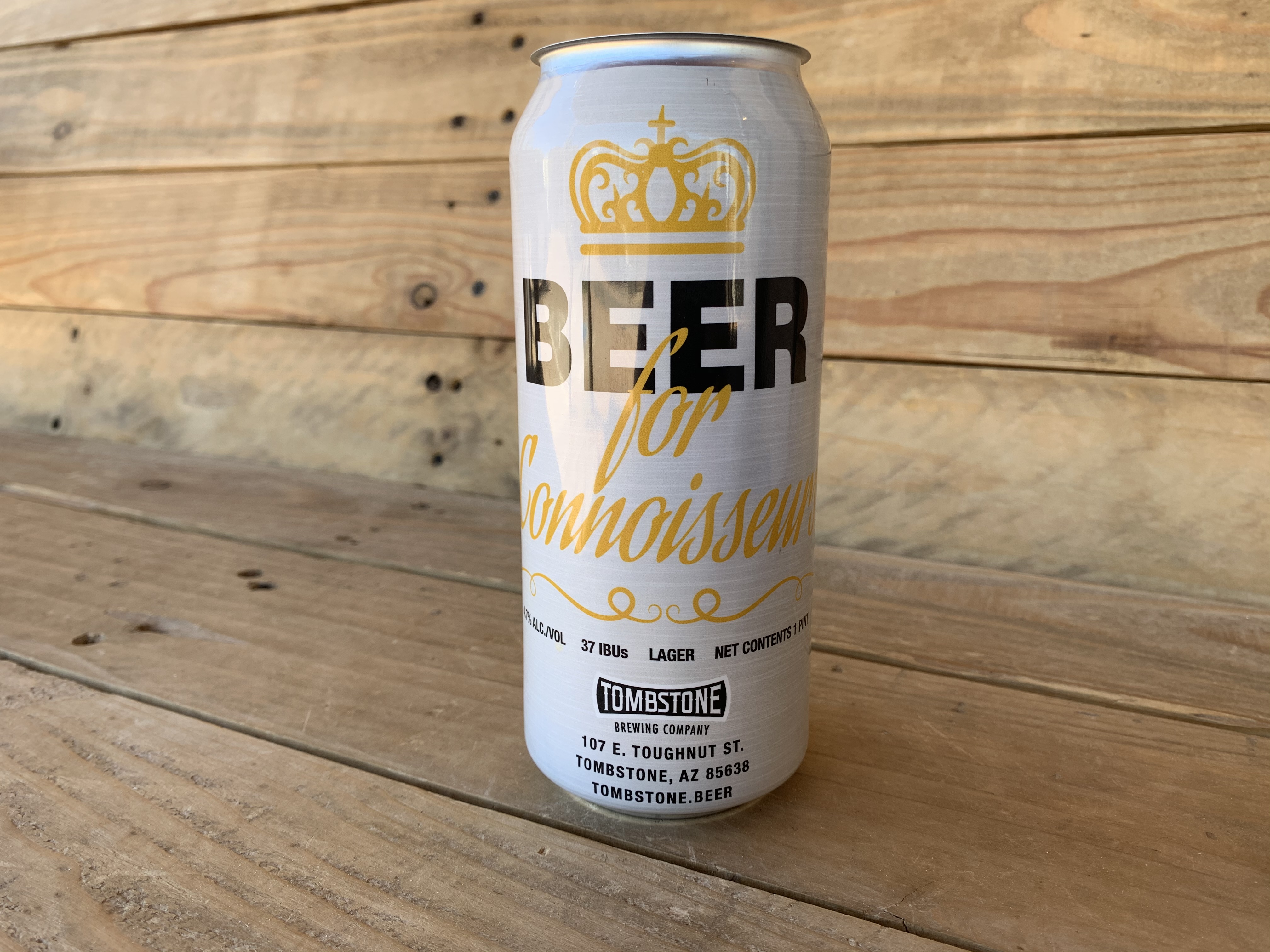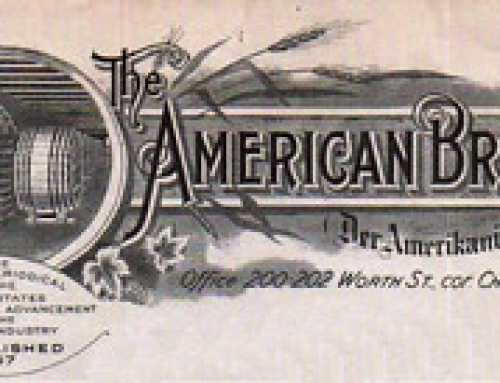In the past couple weeks we’ve had to make a few changes to our production schedule due to unforeseen circumstances. Fortunately, our schedule has been only slightly impacted and the biggest change from our plan actually resulted in something that I’m pretty excited about anyways. For almost a year now, I’ve been joking that Tombstone was going to release a clone of Michelob Original, and that joke slowly evolved into a real beer and due to some supply chain issues, it’s evolved into two beers that share a lot of history. The process for developing these recipes has been a fascinating history lesson that ties together 3 of the most important people in the history of lager brewing and it has really tied together a lot of the science and art of brewing for me to enjoy.
The whole idea started off with a joke of saying I had a recipe for Michelob the way it was brewed in 1896, the year in which it was first released by Anheuser-Busch in America. The joke part of it was that a lot of brewers claim to produce historical recreations of old recipes and in fact, they just use a kind of standard recipe, throw a retro looking label on it, and claim it’s a reintroduction of an old beer (I’m looking at you Pabst! How many beers historically inaccurate beers do you need in that portfolio?!?). The “recipe” that I had was really just a list of common ingredients that looked more like an incomplete shopping list. No brewing logs exist (according to a few of my contacts at Anheuser-Busch) from 1896 to truly know the exact recipe that was used for Michelob. But as I read the history of the beer, I became much more interested in doing my best to recreate it as accurately as possible.
What a lot of people don’t realize is that a significant amount of American history from before World War II has been forgotten or records for events were lost. When you couple that with prohibition being a period of time in which brewing records were thrown out, it’s no surprise that people have forgotten that at one point in time, Michelob was considered by many to be not just one of the most premium lagers in America, but in the whole world. Adolphus Busch wanted a beer that he could claim was a premium product and so Michelob was developed as an all malt lager using two-row barley, imported hops from the Saazer region, and a pure culture yeast strain. Considering the time period, those three attributes were very rare to find in any American beer. Instead of trying to make Michelob a mass produced beer, Adolphus Busch sold the beer at a premium without marketing it in any way other than to tell bars that Michelob was a “beer for connoisseurs.” It seemed too fitting that today so many people think of a beer connoisseur as being the pastry stout drinkers or IPA drinkers, but brewers will normally tell you that it’s the beer flavored beer that is for the real connoisseurs.
Trying to recreate the recipe without a logbook makes it nearly impossible to know for sure how close we came to the true recipe which is a large reason that in the past when I’ve focused on historic recreations, it hasn’t been with the goal of replicating an exact beer, but rather a historic style. The difference in this case is that I believe I have enough sources and methods of double checking my work that I feel confident in saying this recipe is as close as it can get.
Trying to find a place to start, I began with the easiest ingredient to determine: hops. In promotional material leading up to the 1896 release of the first batch of Michelob, it was declared that the “finest lager in the world” was brewed with nothing but the finest Saaz hops. I reached out to a beer historian and asked him for any information he might have about hop usage from Anheuser-Busch in the 1890’s. In the material he sent me, I found two letters in different years from Adolphus Busch that reported how much hops were purchased in each year and how much hops they had in inventory. In the letter, Adolphus Busch declared that their goal was to be prepared and to always have enough hops for 2 years of production. I was able to find production volumes from 1882-1890 and was able to confirm that the average amount of hops used at their brewery was fairly typical of the time period, maybe just a little high at 2 lbs of hops per bbl of beer. In other material from many years later, I was able to find that Michelob used “30% more hops” although the source didn’t specify “more hops than _____.” I took that to mean 30% more than the average amount of hops used in other AB beers resulting in 2.6 lbs of hops per bbl. Knowing that the goal of the beer was to compete with the finest Bohemian lagers of the time, I guessed that would put the IBU’s in the ballpark of 40 IBU.
Not being content with guesswork though, I looked into hop schedules typical of American breweries at the time and found words written by Dr. Robert Wahl in a brewing textbook that suggested that the most common hop schedule would be a 2:2:1 ratio with additions at 60 minutes, 20 minutes, and flameout. Taking the average alpha acids of Saaz, I plugged my estimate of 2.6 lbs of hops per bbl with that ratio into an IBU calculator, took into account that they used leaf hops and a steam boil kettle for hop utilization rates and came up with 37 IBU.
Having the easy part of the recipe out of the way, I moved on to a slightly more frustrating ingredient: Malts. Adolphus Busch made the claim in 1896 that Michelob was an all malt beer. That was rare in America because the overwhelming majority of the barley being grown in the USA was 6-row that was high in protein content. Brewing a beer entirely with 6-row resulted in a protein haze which was why American brewers used corn and rice. I was able to find an article in which Busch did say that Michelob used 2-row and another article that claimed that Anheuser Busch was using American grown 2-row. 2-row was really only being grown in Western America at the time and only a few varieties were being grown. I was able to find a list of varieties being grown in a journal, again written by Dr. Robert Wahl, and two varieties stuck out to me: Hanna and Chevalier. Hanna was a barley type that was successfully grown in the USA after seed was brought from Moravia. Chevalier was more common in the USA at the time than Hanna, but less well suited for lager brewing.
The easiest solution would have been to just say “Barley variety doesn’t matter as much as the malting of the barley” and roll with any domestic Pilsner malt. My goal being a true recreation though, I couldn’t let myself settle with that. One of the toughest things with trying to recreate a beer from a specific period is that a lot of ingredients just aren’t available at all anymore. For weeks I reached out to barley growers, maltsters, brewers, and beer historians to try to find the most appropriate malt. Most people just thought the idea of going to this length to recreate a macro lager was funny and I had to explain it’s not really a macro lager… It used to be glorious. After a few weeks, I did find a list of barley varieties that was used in the 1960’s. It wasn’t much considering that the list was from 65 years after the recipe was first brewed, but it did confirm that hanna and chevalier were both good suspicions. I settled on Hanna because it is better suited for lagers and would definitely have been used in almost every Bohemian brewery that Busch was trying to emulate. It’s not common to find Hanna barley itself anymore, but a lot of barley varieties were bred from Hanna. Luckily, Rahr Malting sells an “Old World Pils” malt that is malted either from Hanna or from a close relative to Hanna and it is even slightly less modified the way malts would have been in the 1890’s.
The final piece of the puzzle, yeast, was definitely the difficult part of this project and really, it is the part of this that got me most interested to proceed. So much of my data for my ingredient decisions came from Dr. Robert Wahl. Incredibly, he’s a forgotten figure in American brewing. Dr. Wahl fought against an American Beer Purity Law, he started his own brewing school in Chicago, he designed an enclosed fermenter that allowed for proper yeast harvesting almost 50 years before the introduction of the conical fermenter that is most common in breweries today, he was one of the first Americans to isolate yeast, he fought against prohibition and continued to study beer production in near isolation throughout prohibition, and he was an advocate for the sharing of brewing information throughout the whole world.
I got a lead from a book that’s available on Google written by Dr. Wahl. In one of his excerpts, he tells a story in which he brings yeast to Adolphus Busch from a brewery in Michelob, Bohemia. The brewery was owned by Anton Dreher, the son of the brewer (whose name was also Anton Dreher) that is credited with the invention of the pale lager. The younger Dreher took over the business from his father and Dr. Wahl visited him at his more well-known brewery in Austria. He was sent there by Adolphus Busch himself and at Busch’s request, Dr. Wahl asked Dreher for information about his beer and requested a sample of yeast. Dreher confessed that the beer in question was actually brewed in their Michelob brewery and Dr. Wahl went there to obtain the yeast for Busch. He brought it back to America and he analyzed the yeast, determined it to be a pure culture, and gave it to Anheuser Busch.
Finding a yeast strain from 125 years ago was definitely going to be the thing that brought this project to a crashing halt. I did find that Dr. Wahl propagated and sold the yeast throughout North America in the following years. Prohibition killed his business though and I couldn’t find any information about breweries that had bought this yeast. The challenge was that even if I could find a brewery that had used the yeast 125 years ago and was still operating, the yeast would definitely have evolved. I put out a request for any information about Dr. Wahl and to my astonishment, I was introduced to his great-great-grandson. Roger Wahl was kind enough to provide me with a few books written by Dr. Wahl. I consulted with a yeast geneticist who was able to confirm that all known lager yeast strains can be traced back to two breweries: Carlsberg and Tuborg.
Just a little over a decade before Michelob was introduced, Emil Christian Hansen successfully isolated two lager yeast strains. Tuborg yeast was actually isolated the year before Carlsberg yeast even though Carlsberg is credieted with being the first brewery to use pure yeast. Tuborg decided not to use the yeast strain that was isolated from their beer because they preferred the Carlsberg yeast. Carlsberg yeast was much easier to maintain, didn’t mutate as fast, could be used for more generations, and perhaps most importantly, it could be washed. The Tuborg isolate created a more flavorful lager (which is arguably a detriment when you want to produce a crisp, clean lager), but was significantly more difficult to use. Dr. Hansen wasn’t stingy with the yeast and he offered samples of pure yeast cultures directly from the Carlsberg Research Center for any brewery that wanted it. Prior to that time, if a brewery had a contamination, they just borrowed yeast from another brewery and the beer took on a new flavor. Now, brewers could isolate and propagate yeast thanks to Hansen’s research and those two strains spread and evolved all over Europe.
Speaking with the yeast geneticist, he was able to confirm that Anheuser Busch yeast originated from the less commonly used Tuborg isolate. But we couldn’t confirm that Michelob was the same yeast being used in Budweiser. We were also able to confirm that Augustiner yeast was from the Tuborg isolate and when reading one of the books provided by Roger Wahl, I found an interesting note that the “less common” yeast from Carlsberg Research Center had traveled throughout the years to Anton Dreher’s Michelob brewery. With data from DNA fingerprinting and from Wahl’s journal, I was able to conclude that the Tuborg yeast was used at Augustiner and Dreher was able to get yeast from them which he took to his Michelob brewery, and from there it had a few years to evolve before it made its way to Anheuser Busch and that it was the likely source for all of AB’s lager yeast. That still wasn’t incredibly helpful because Anheuser Busch doesn’t share yeast and that strain has now been used for 125 years with varying ingredients throughout that time resulting in genetic drift of the yeast.
The last clue I got about the yeast was that before the late 1980’s Anheuser Busch went back to their original yeast culture and propagated new yeast rather than continuing to repitch. I searched every yeast bank I knew of for any connection to their yeast and got very lucky. The USDA had a culture from Anheuser Busch from 1972 and the biologist that isolated it had done so from first generation yeast, so it wouldn’t have had time to evolve.
After several weeks of all this research, I ordered all the ingredients and prepared for a brew day only to find out that our yeast lab had been shut down and couldn’t propagate the yeast in time for me. It was a bit of a happy accident though because we did have access to Augustiner yeast and so I proceeded with the beer as it was originally brewed by Anton Dreher. This version of the beer will be canned in about 6 weeks and will be called “Dreher’s Original Bohemian Lager” and when our lab is back open, we will introduce the beer with the original yeast strain as planned named “Beer for Connoisseurs.”



Awesome post! Thanks for sharing. I only wish I lived anywhere near there to try the beer. I’m not sure when this post was originally released so I may be way off on my wish regardless.
This is exactly what I’ve been looking for. I have (current count) 6 original 9” tall iconic Michelob bottles from the 60’s. My goal is to brew an old school Michelob and bottle some of it in the vintage bottles. Your blog post has me going in the right direction with building out the recipe. Thank you so much for doing the research and publish the history and recipe.
Roy